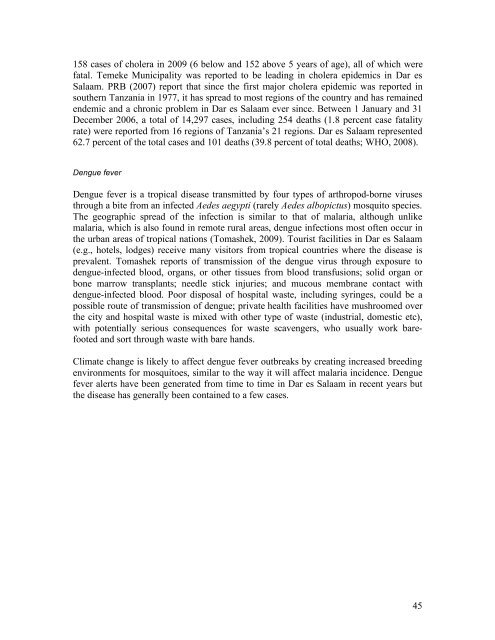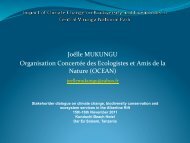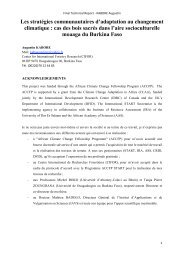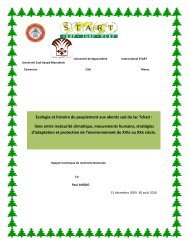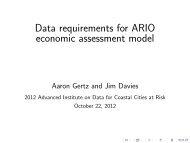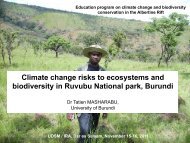Urban Poverty & Climate Change in Dar es Salaam, Tanzania:
Urban Poverty & Climate Change in Dar es Salaam, Tanzania:
Urban Poverty & Climate Change in Dar es Salaam, Tanzania:
Create successful ePaper yourself
Turn your PDF publications into a flip-book with our unique Google optimized e-Paper software.
158 cas<strong>es</strong> of cholera <strong>in</strong> 2009 (6 below and 152 above 5 years of age), all of which were<br />
fatal. Temeke Municipality was reported to be lead<strong>in</strong>g <strong>in</strong> cholera epidemics <strong>in</strong> <strong>Dar</strong> <strong>es</strong><br />
<strong>Salaam</strong>. PRB (2007) report that s<strong>in</strong>ce the first major cholera epidemic was reported <strong>in</strong><br />
southern <strong>Tanzania</strong> <strong>in</strong> 1977, it has spread to most regions of the country and has rema<strong>in</strong>ed<br />
endemic and a chronic problem <strong>in</strong> <strong>Dar</strong> <strong>es</strong> <strong>Salaam</strong> ever s<strong>in</strong>ce. Between 1 January and 31<br />
December 2006, a total of 14,297 cas<strong>es</strong>, <strong>in</strong>clud<strong>in</strong>g 254 deaths (1.8 percent case fatality<br />
rate) were reported from 16 regions of <strong>Tanzania</strong>’s 21 regions. <strong>Dar</strong> <strong>es</strong> <strong>Salaam</strong> repr<strong>es</strong>ented<br />
62.7 percent of the total cas<strong>es</strong> and 101 deaths (39.8 percent of total deaths; WHO, 2008).<br />
Dengue fever<br />
Dengue fever is a tropical disease transmitted by four typ<strong>es</strong> of arthropod-borne virus<strong>es</strong><br />
through a bite from an <strong>in</strong>fected Aed<strong>es</strong> aegypti (rarely Aed<strong>es</strong> albopictus) mosquito speci<strong>es</strong>.<br />
The geographic spread of the <strong>in</strong>fection is similar to that of malaria, although unlike<br />
malaria, which is also found <strong>in</strong> remote rural areas, dengue <strong>in</strong>fections most often occur <strong>in</strong><br />
the urban areas of tropical nations (Tomashek, 2009). Tourist faciliti<strong>es</strong> <strong>in</strong> <strong>Dar</strong> <strong>es</strong> <strong>Salaam</strong><br />
(e.g., hotels, lodg<strong>es</strong>) receive many visitors from tropical countri<strong>es</strong> where the disease is<br />
prevalent. Tomashek reports of transmission of the dengue virus through exposure to<br />
dengue-<strong>in</strong>fected blood, organs, or other tissu<strong>es</strong> from blood transfusions; solid organ or<br />
bone marrow transplants; needle stick <strong>in</strong>juri<strong>es</strong>; and mucous membrane contact with<br />
dengue-<strong>in</strong>fected blood. Poor disposal of hospital waste, <strong>in</strong>clud<strong>in</strong>g syr<strong>in</strong>g<strong>es</strong>, could be a<br />
possible route of transmission of dengue; private health faciliti<strong>es</strong> have mushroomed over<br />
the city and hospital waste is mixed with other type of waste (<strong>in</strong>dustrial, dom<strong>es</strong>tic etc),<br />
with potentially serious consequenc<strong>es</strong> for waste scavengers, who usually work barefooted<br />
and sort through waste with bare hands.<br />
<strong>Climate</strong> change is likely to affect dengue fever outbreaks by creat<strong>in</strong>g <strong>in</strong>creased breed<strong>in</strong>g<br />
environments for mosquito<strong>es</strong>, similar to the way it will affect malaria <strong>in</strong>cidence. Dengue<br />
fever alerts have been generated from time to time <strong>in</strong> <strong>Dar</strong> <strong>es</strong> <strong>Salaam</strong> <strong>in</strong> recent years but<br />
the disease has generally been conta<strong>in</strong>ed to a few cas<strong>es</strong>.<br />
45


